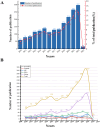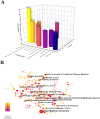Knowledge domain and emerging trends in post-stroke cognitive impairment: a bibliometric analysis
- PMID: 40103932
- PMCID: PMC11913868
- DOI: 10.3389/fnagi.2025.1525626
Knowledge domain and emerging trends in post-stroke cognitive impairment: a bibliometric analysis
Abstract
Background: Cognitive impairment is an important cause of disability and death among the elderly. One of the most important risk factors is stroke. Post-stroke cognitive impairment (PSCI) not only diminishes the quality of life for patients but also increases the burden on families and society. But PSCI can be mitigated through early intervention. Cerebral small vessel disease (CSVD) is one of the significant causes of stroke and has garnered considerable attention in PSCI. Therefore, this study aims to identify research priorities and trends in PSCI through bibliometric analysis, and further explore the role played by CSVD in PSCI.
Methods: In this study, we performed a systematic search in the Science Citation Index Expanded (SCI-E) of the Web of Science Core Collection (WoSCC). VOSviewer, CiteSpace and Origin were mainly used to visualize the research focus and trend in PSCI. In addition, we screened the retrieved literature again, and performed keyword analysis on the studies related to CSVD.
Results: A total of 1,943 publications were retrieved in the field of PSCI in this study, with consistent upward trend in annual publications in recent years. Pendlebury was an important leader in PSCI research. Capital Medical University was in the leading position judging from the number of publications. China had the highest number of publications in this field. The journal Stroke had the strongest international influence in this field. Keywords such as "functional connectivity," "tool," "systematic review," and "meta-analysis" have been revealed to have momentous impact on PSCI in recent years. In the further analysis of PSCI and CSVD, "hypertension," "white matter hyperintensities (WMH)," "cerebral microbleeds (CMBs)," and "cerebral amyloid angiopathy (CAA)" received extensive attention.
Conclusion: The study of PSCI is still in the development stage. This study systematically summarizes the progress and development trend in the field of PSCI, and further explores the relationship between CSVD and PSCI through hypertension and magnetic resonance imaging markers. This study is of great significance for researchers to quickly understand the development of PSCI, but also helps them understand future directions, and provides important insights for the prevention and treatment of PSCI.
Keywords: CiteSpace; VOSviewer; bibliometrics; cerebral small vessel disease; cognitive impairment; post-stroke cognitive impairment; stroke; visual analytics.
Copyright © 2025 Zhang, Li, Zhan, Long, Shen, Chen, Qian, Pan, Wu, Wang, Wu and Huang.
Conflict of interest statement
The authors declare that the research was conducted in the absence of any commercial or financial relationships that could be construed as a potential conflict of interest.
Figures









Similar articles
-
Research trends and hotspots of post-stroke cognitive impairment: a bibliometric analysis.Front Pharmacol. 2023 May 30;14:1184830. doi: 10.3389/fphar.2023.1184830. eCollection 2023. Front Pharmacol. 2023. PMID: 37324494 Free PMC article. Review.
-
Post-stroke cognitive impairment: A bibliometric and knowledge-map analysis.NeuroRehabilitation. 2023;52(2):175-186. doi: 10.3233/NRE-220203. NeuroRehabilitation. 2023. PMID: 36565073
-
A bibliometric analysis of cerebral microbleeds and cognitive impairment.Brain Cogn. 2023 Jul;169:105999. doi: 10.1016/j.bandc.2023.105999. Epub 2023 May 30. Brain Cogn. 2023. PMID: 37262941 Review.
-
Cerebral small vessel disease and post-stroke cognitive impairment.Int J Neurosci. 2017 Sep;127(9):824-830. doi: 10.1080/00207454.2016.1261291. Epub 2016 Nov 28. Int J Neurosci. 2017. PMID: 27838946 Review.
-
Research status and trends of functional magnetic resonance imaging technology in the field of acupuncture: a bibliometric analysis over the past two decades.Front Neurosci. 2025 Jan 30;19:1489049. doi: 10.3389/fnins.2025.1489049. eCollection 2025. Front Neurosci. 2025. PMID: 39949895 Free PMC article. Review.
References
-
- Barrett K. M., Brott T. G., Brown R. D., Carter R. E., Geske J. R., Graff-Radford N. R., et al. . (2011). Enhancing recovery after acute ischemic stroke with donepezil as an adjuvant therapy to standard medical care: results of a phase IIA clinical trial. J. Stroke Cerebrovasc. Dis. 20, 177–182. 10.1016/j.jstrokecerebrovasdis.2010.12.009 - DOI - PubMed
-
- Bloomfield G. S., Baldridge A., Agarwal A., Huffman M. D., Colantonio L. D., Bahiru E., et al. . (2015). Disparities in cardiovascular research output and citations from 52 African countries: a time-trend, bibliometric analysis (1999-2008). J. Am. Heart Assoc. 4:e001606. 10.1161/JAHA.114.001606 - DOI - PMC - PubMed
-
- Brainin M., Matz K., Nemec M., Teuschl Y., Dachenhausen A., Asenbaum-Nan S., et al. . (2015b). Prevention of poststroke cognitive decline: ASPIS–a multicenter, randomized, observer-blind, parallel group clinical trial to evaluate multiple lifestyle interventions–study design and baseline characteristics. Int. J. Stroke 10, 627–635. 10.1111/ijs.12188 - DOI - PubMed
LinkOut - more resources
Full Text Sources

